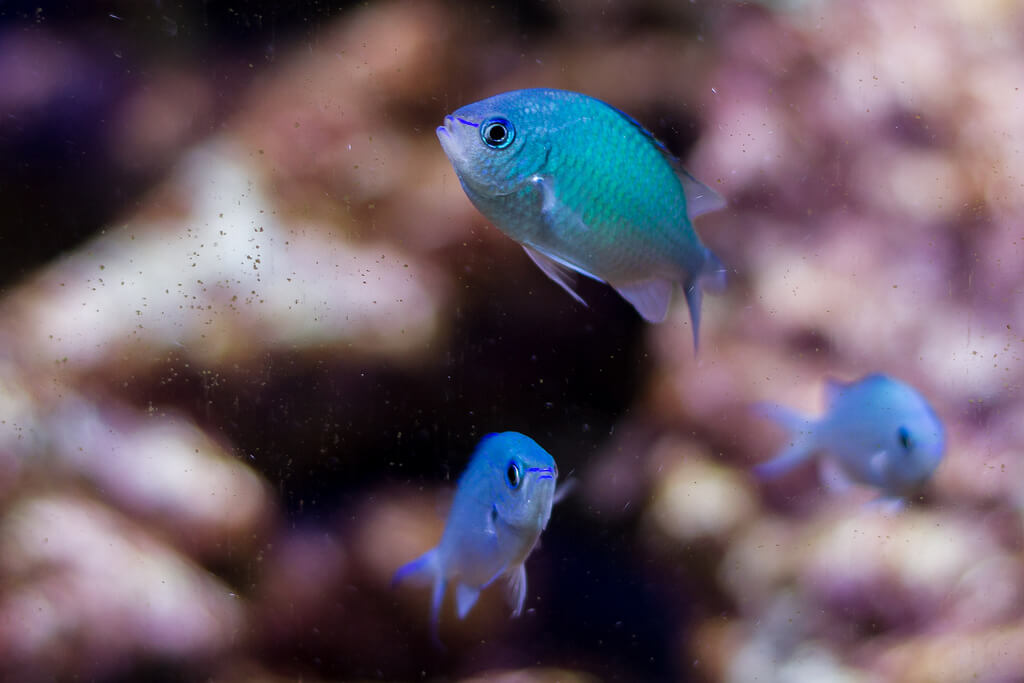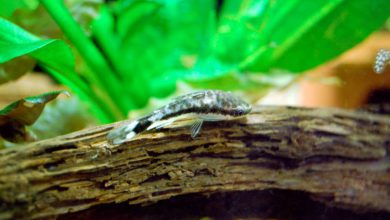How to Lower pH in an Aquarium or Fish Tank

Getting your water chemistry right is crucial for a healthy fish tank. While there are many different factors to consider, one of the most important is the pH of your aquarium water.
All too often the pH of standard tap water is far too high for many species, so in this guide we will discuss how to lower the pH of your aquarium or fish tank water.
Understanding the Concept of pH

Before we get to the ways in which you can lower the pH in your aquarium, lets try to understand what this means.
Water is composed of hydrogen and oxygen molecules. In its neutral form, where it has equal numbers of hydrogen (H+) ions and hydroxide (OH-)ions, water has a pH of 7.0.
If any chemicals or minerals get dissolved in this water, the balance of ions will move from the original state. If the hydrogen ions increase in number, the water becomes more acidic and if the hydroxide ions increase, it becomes alkaline.
These states are referred to as low and high pH respectively, with acid coming on the low side and alkalis on the high side.
The acidity and alkalinity are measured on the pH scale for convenience.
How Do I Check the pH?
Checking the pH of your fish tank is a very easy exercise. There are a host of testing kits that available in the market which will allow you to quickly and easily monitor the pH in your tank.
If you’re on a budget then many reputable aquarium stores will actually test your aquarium water for you – often for free. Just appreciate that this option, while cheaper, can be less practical when you’re trying to continually monitor pH in your fish tank.
Do You Need to Lower the pH?
While there are some specified pH levels that are recommended for different types of fish, trying to achieve the perfect pH is a futile exercise.
Instead, check if your fish are doing well in the water. If you notice some bloating, loss of appetite, or other signs of distress, you will need to take out a test kit and check the pH.
If the ideal pH is off by a bit but the fish aren’t showing any signs of trouble, you can leave it at that. Keep in mind that fish are very sensitive to changes in pH so stability is the most important factor.
Ways to Lower pH
If you notice that there is something wrong with your fish and find that the pH at a higher level than intended, you will need to take steps to remedy this. The pH can be lowered in a number of ways, most of which are natural. Here are some of the best solutions…
Water Change
One possible reason for the pH increasing or decreasing in your tank is dirty water. If you haven’t been changing the water of your aquarium frequently, you may want to try that before anything else.
However don’t just change all the water in the aquarium at once. Firstly, be sure to test the pH of the fresh water you’re planning to add, to ensure that it won’t actually make the problem worse. Additionally, it is less stressful for your fish if smaller, more regular water changes are carried out over an extended period of time.
Removing any leftover food or waste can also help in lowering the pH of the water so it’s a good idea to get your aquarium vacuum back into service.
Driftwood
A great way to lower the pH of the water in your fish tank is adding driftwood. The best part about this method is that it creates conditions that are similar to the natural habitat of many fish. In addition to this, it is also aesthetically pleasing, bringing some fun changes to your aquarium.
Adding driftwood works by releasing tannins into the water of your aquarium, lowering the pH in a natural way.
It is important that the wood is prepared well before being added to the tank. Try to reduce as much of the color as you can otherwise it can leach into your aquarium water, giving it a brownish hue. You may want to boil the driftwood well before use as this not only helps get rid of the color, but also kills any algae or fungus that could develop on the wood at a later stage.
Peat Moss
Another natural way of lowering the pH of your aquarium water is adding some peat moss to it. While the moss will discolor the water slightly, it is a great way to lower the pH as it releases tannic and gallic acids into the water. This attacks any bicarbonates and reduces the water’s pH and hardness.
Peat moss can be easily bought in the form of pellets or chunks. Simply putting it in the tank for a minute or two will not be helpful. You need to keep it submerged in the tank for a good amount of time for it to be effective. If you want to avoid too much discoloration, start with a small clump and monitor the pH. If it works, you might not need to add more.
Almond Leaves
The third natural remedy to lower the pH level of your aquarium is adding Indian almond or catappa leaves. These can be found at most aquarium or fish shops and make for a great water conditioner.
Usually dried and packaged in strips, you may want to soak them in water before adding them to the fish tank. Not only will this start the process of decomposition, but it will also remove quite a bit of the natural dyes which might otherwise stain your water.
According to most aquarium owners, these leaves work in a manner that is similar to peat moss and driftwood. While all of these options will leave some color in the water, they are the best natural weapons when the pH of your water is too high. They are safe to use and will not harm your fish in any way.
Reverse Osmosis Filter
If the natural methods are not working for you, you can employ the reverse osmosis method. There are reverse osmosis machines that clean water using a partially permeable filter, filtering over 90% of the contaminants – including the ones that increase pH. Smaller ions are allowed in, which makes the water overall healthier.
The downside of this method is that it is expensive and can be a little bulky. However, it can prove to be a great investment in the long run as it will be a complete solution to your pH problems. For people with large aquariums, it is a great option.
Conclusion
Monitoring pH is an important part of keeping your aquarium healthy. Fortunately, with a low-cost testing kit this is simplicity to do.
What’s more, should you find that your fish tank water needs the pH reducing then there are an assortment of resources and techniques that will help you achieve this. Even better, they’re generally chemical-free and may actually add extra interest to your aquarium.
With just a little bit of patience your tank will soon be back to its former self, while the tank inhabitants will all benefit from your efforts.
Photo by chris favero 


